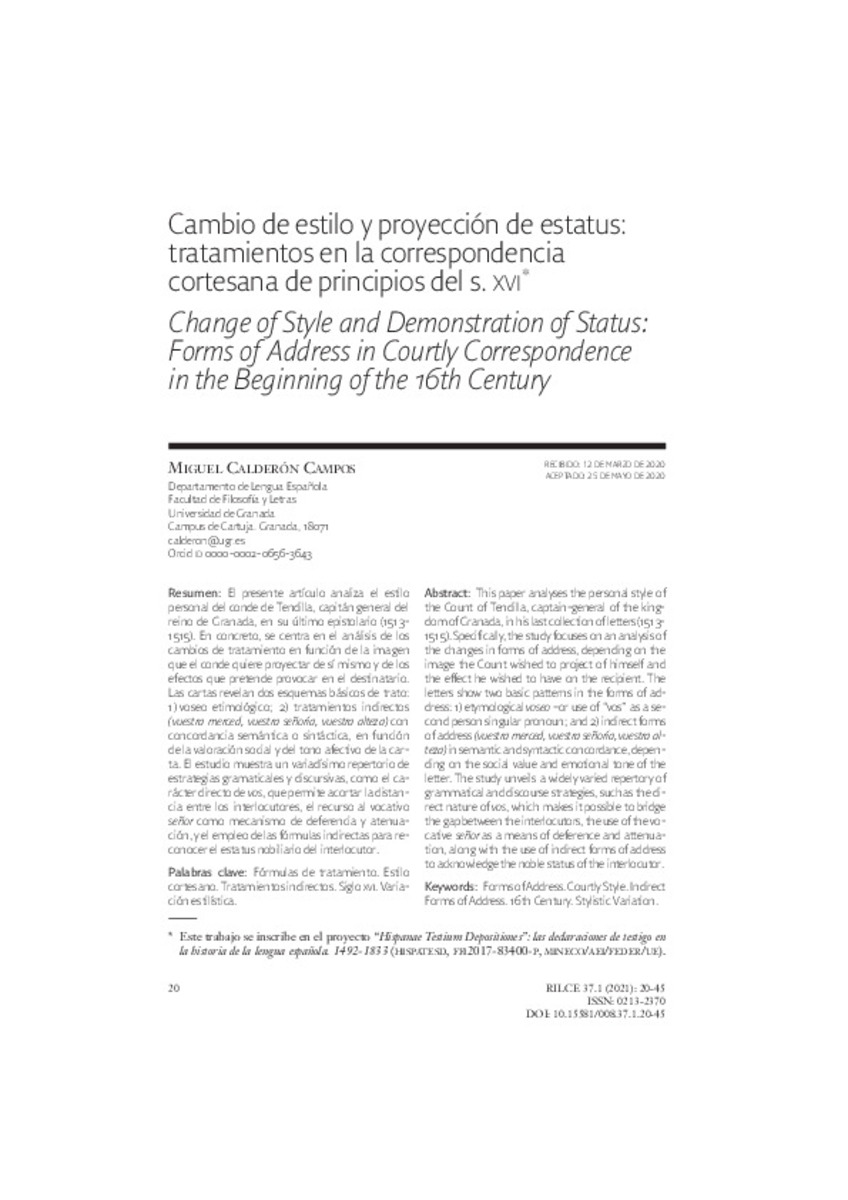Full metadata record
| DC Field | Value | Language |
|---|---|---|
| dc.creator | Campos, M. (Miguel) | - |
| dc.date.accessioned | 2020-12-21 | - |
| dc.date.accessioned | 2021-08-30T07:28:14Z | - |
| dc.date.available | 2021-08-30T07:28:14Z | - |
| dc.date.issued | 2020 | - |
| dc.identifier.citation | Calderón-Campos, M. (Miguel). "Cambio de estilo y proyección de estatus: tratamientos en la correspondencia cortesana de principios del s. XVI". Rilce: Revista de Filología Hispánica. 37 (1), 2020, 20 - 45 | es |
| dc.identifier.issn | 0213-2370 | - |
| dc.identifier.uri | https://hdl.handle.net/10171/61845 | - |
| dc.description.abstract | This paper analyses the personal style of the Count of Tendilla, captain-general of the kingdom of Granada, in his last collection of letters (1513- 1515). Specifically, the study focuses on an analysis of the changes in forms of address, depending on the image the Count wished to project of himself and the effect he wished to have on the recipient. The letters show two basic patterns in the forms of address: 1) etymological <em>voseo </em>–or use of “vos” as a second person singular pronoun; and 2) indirect forms of address <em>(vuestra merced, vuestra señoría, vuestra alteza) </em>in semantic and syntactic concordance, depending on the social value and emotional tone of the letter. The study unveils a widely varied repertory of grammatical and discourse strategies, such as the direct nature of <em>vos</em>, which makes it possible to bridge the gap between the interlocutors, the use of the vocative <em>señor </em>as a means of deference and attenuation, along with the use of indirect forms of address to acknowledge the noble status of the interlocutor. | en_US |
| dc.description.abstract | El presente artículo analiza el estilo personal del conde de Tendilla, capitán general del reino de Granada, en su último epistolario (1513- 1515). En concreto, se centra en el análisis de los cambios de tratamiento en función de la imagen que el conde quiere proyectar de sí mismo y de los efectos que pretende provocar en el destinatario. Las cartas revelan dos esquemas básicos de trato: 1) voseo etimológico; 2) tratamientos indirectos <em>(vuestra merced, vuestra señoría, vuestra alteza) </em>con concordancia semántica o sintáctica, en función de la valoración social y del tono afectivo de la carta. El estudio muestra un variadísimo repertorio de estrategias gramaticales y discursivas, como el carácter directo de <em>vos</em>, que permite acortar la distancia entre los interlocutores, el recurso al vocativo <em>señor </em>como mecanismo de deferencia y atenuación, y el empleo de las fórmulas indirectas para reconocer el estatus nobiliario del interlocutor. | es_ES |
| dc.language.iso | spa | - |
| dc.publisher | Servicio de Publicaciones de la Universidad de Navarra | es_ES |
| dc.rights | info:eu-repo/semantics/openAccess | es_ES |
| dc.subject | Fórmulas de tratamiento | - |
| dc.subject | Estilo cortesano | - |
| dc.subject | Tratamientos indirectos | - |
| dc.subject | Siglo XVI | - |
| dc.subject | Variación estilística | - |
| dc.title | Cambio de estilo y proyección de estatus: tratamientos en la correspondencia cortesana de principios del s. XVI | es_ES |
| dc.title.alternative | Change of Style and Demonstration of Status: Forms of Address in Courtly Correspondence in the Beginning of the 16th Century | en_US |
| dc.type | info:eu-repo/semantics/article | es_ES |
| dc.identifier.doi | 10.15581/008.37.1.20-45 | - |
| dadun.citation.endingPage | 45 | - |
| dadun.citation.number | 1 | - |
| dadun.citation.publicationName | Rilce: Revista de Filología Hispánica | - |
| dadun.citation.startingPage | 20 | - |
| dadun.citation.volume | 37 | - |
Files in This Item:
Statistics and impact
Items in Dadun are protected by copyright, with all rights reserved, unless otherwise indicated.






